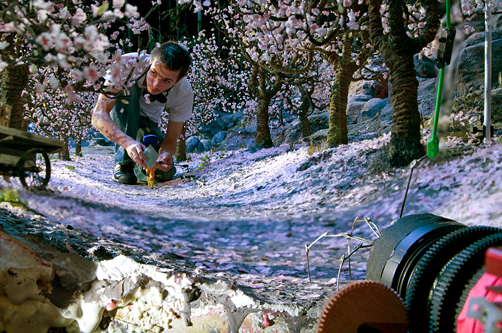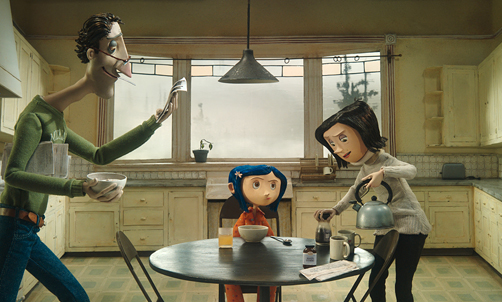Coraline the book is a magical, creepy children’s story from Neil Gaiman about a girl who finds a hidden doorway in her house that leads to another world. Coraline the film is both a wonderful translation to the screen, a work of art, and another proud testament to the fact that stop-motion animation, while dying out, is far from gone yet. I’m going to start out with a request: please do yourselves a favour and go see it soon while it’s still in 3D screens. This will be quite unlike the gimmicky effects to which you are used, with “this is the 3D bit” moments. Instead the entire thing was shot with stereoscopic cameras so it’s all just… 3D. As if that were totally normal. The difference is that it generally adds depth by moving into the screen rather than trying to burst out of it, which is when the illusion tends to break.
Given the couple of 3D trailers preceding the film, this is a tipping point. Ice Age certainly seems to have embraced it just as fully and naturally. In fact the 3D view confused me at first, my eyes straining as I struggled to take everything in at once as I normally would with a film. Instead you should look around the scene unfolding before you, focusing on one layer at a time, just as in real life. However I’m not about to start saying that this is the future for all films, because you’re losing something too: the vibrant colours do appear washed out through the polarised glasses and I suppose you lose that big screen spectacle where you can take in everything at once in a detailed 2D shot. Not to mention the unnecessary surcharge for the privilege of 3D, a bit steep for glasses they’re collecting up afterwards (okay, and a digital two-level projector, but that’s an investment).
There is far more to the film than this effect, of course, and more than enough to make a 2D viewing worthwhile. Stop-motion always offers something tantalisingly different from the now-standard digitally animated fare, though it is often hard to put one’s finger on. And the calibre here is the very highest, directed by the legendary Henry Sellick who also helmed The Nightmare Before Christmas (despite the fact it tends to be Tim Burton of whom people first think since his writing and design permeates much of it). The painstaking process of shooting and adjusting in individual frames is almost impossible to imagine, but the result is somehow more grounded, with more precise movements and a sense of weight. It is truer here than in Corpse Bride where, arguably, the pursuit of smooth visual perfection resulted in something that looked digital. The love and care from the team at Laika often permeate the world on display before you which is a joy to behold. As their marketing revealed, these guys are artisans. And so it is that what really sticks with you from the film are the stunning environments even moreso than the characters and story which meander through them.
I won’t bother dealing with the “controversy” of scaring kids, since you know my thoughts. Young kids will undoubtedly be frightened from time to time by the strangely dislocated other world which Coraline discovers. The Other Mother is suitably creepy incarnation and a perfect realisation of Coraline’s adversary. Bottom line is: it’ll probably scare kids and they’ll love it. I must admit I was perplexed, however, by the Sellick’s choice in the corpulant geriatric mild nudity of Spink and Forcible’s act in the other world. While there is much for adults to enjoy, Coraline is still clearly a kids’ film so it feels awkwardly out of place. On the other hand kids may not even notice.



Leave a Reply